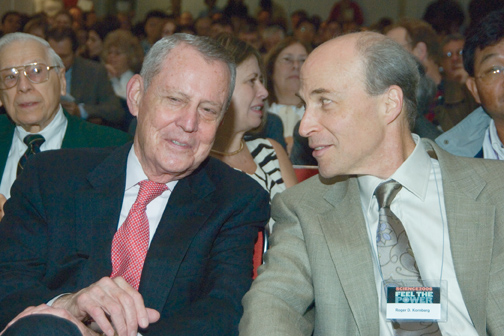Pitt’s Dickson Prize Winner Kornberg Also Awarded 2006 Nobel Prize in Chemistry

“Grateful as I am for the recognition, there is just no thrill to match that of a discovery,” Stanford University scientist Roger D. Kornberg said here Oct. 5—immediately after receiving Pitt’s Dickson Prize in Medicine and a day after being notified that he had been awarded the 2006 Nobel Prize in Chemistry. Scientific discovery “is indescribably exciting and beautiful,” said Kornberg, pictured above with transplantation pioneer Thomas E. Starzl, Distinguished Service Professor of Surgery in Pitt’s School of Medicine. Kornberg was honored for his groundbreaking research toward understanding how DNA is converted into RNA, a process known as transcription.
The Dickson Prize, the most prestigious award presented by Pitt’s medical school, recognizes individuals who have made significant, progressive contributions to medicine. It was established in 1969 by the estates of Joseph Z. Dickson, M.D., and his wife, Agnes Fischer Dickson.
Kornberg is the 11th Dickson Prize-winner to also receive the Nobel Prize. “The Dickson Prize has often been followed by a Nobel, but usually not within a day,” said Arthur S. Levine, Pitt senior vice chancellor for health sciences and dean of the medical school.
Kornberg’s Dickson Prize in Medicine Lecture, titled “Chromatin and Transcription,” was part of Pitt’s sixth annual science and technology showcase, Science2006: Feel the Power. It was Kornberg’s first public appearance since being notified that he’d won the Nobel.
“The Nobel Prize is given for a particular discovery and not as a recognition of scientific greatness. The two are often conflated in the popular imagination,” Kornberg modestly told reporters following his lecture. “I know many truly great scientists who never have or ever will win the prize.”
Other Stories From This Issue
On the Freedom Road

Follow a group of Pitt students on the Returning to the Roots of Civil Rights bus tour, a nine-day, 2,300-mile journey crisscrossing five states.
Day 1: The Awakening
Day 2: Deep Impressions
Day 3: Music, Montgomery, and More
Day 4: Looking Back, Looking Forward
Day 5: Learning to Remember
Day 6: The Mountaintop
Day 7: Slavery and Beyond
Day 8: Lessons to Bring Home
Day 9: Final Lessons

